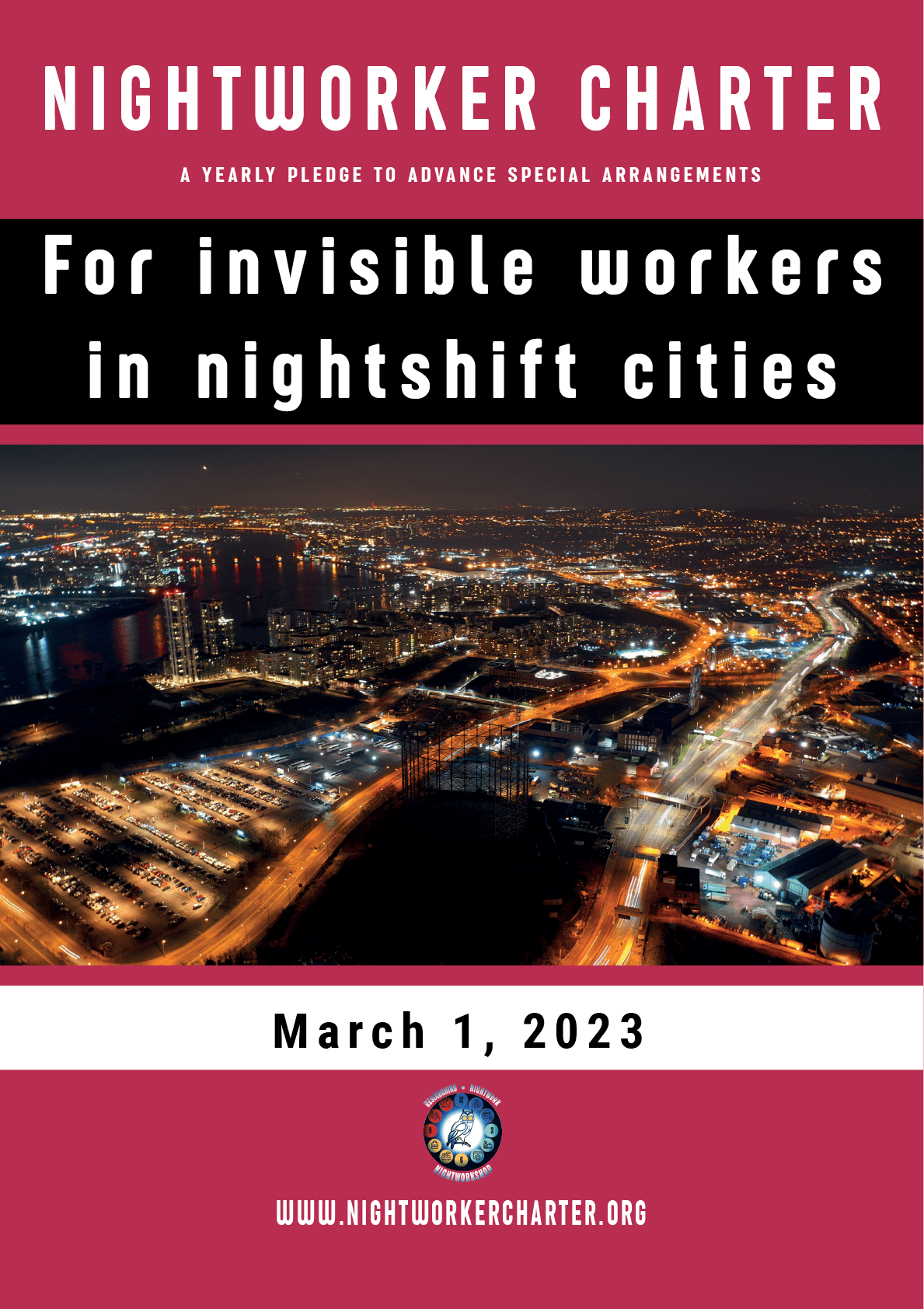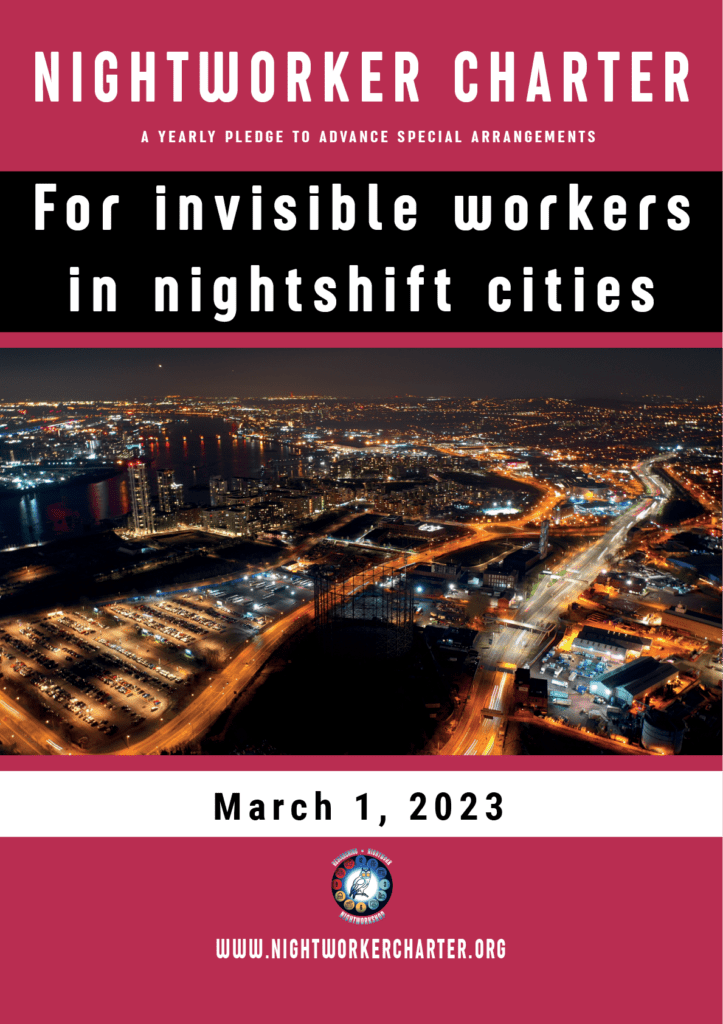
Julius-Cezar MacQuarie is a Marie-Skłodowska Curie Fellow at the Institute for Social Science in the 21st Century | University College Cork. He leads PRECNIGHTS, a project on Precarity in Women Migrant Nightworkers in Ireland, under the mentorship of Dr Caitríona Ni Laoire. Over the years, he reached out to people inhabiting the night in various capacities: as a night ethnographer, migration scholar, outreach worker and collaborator with NGOs working with vulnerable groups. His upcoming book Invisible Migrant Nightworkers in 24/7 London is complemented by a short-film trilogy: Invisible Lives (2013), Nocturnal Lives(2015), and Nightshift Spitalfields (2020); and a podcast series, NightWorkPod Podcast with CEU Podcasts. The latest output of his project is the Nightworker Charter, an example of action-based research and committed ethnography proposing a set of special arrangements to recognize, address, and repair the specific problems with nightwork.
The following interview was conducted by LeftEast’s Tibor Meszmann.
For over a decade, you have been researching vulnerable and marginalized Romanian migrant nightworkers in London’s night time economy, especially in the food industry, including food production, processing, distribution… While working at night, I guess during the day as a social anthropologist you were also working on innovating an applied methodology, which you call the night workshop methodology. Could you tell us more about the nightshift workers – e.g. their demographic characteristics, educational attainment, and motivations to go to the UK? And more particularly, what are their motivations to engage in nightshift work? How did your methods help unveil and understand the world of nightworkers?
Thank you very much for the invitation and I’m delighted to have this conversation on the less talked about topic of nightwork and problems in nightwork. First, I’d like to give a brief background and context for the LeftEast audience, the readers, and potential listeners.
It starts with my experience. We go back nearly three decades when I was a migrant worker in the mid-90s in Istanbul. That experience influenced me in terms of my choice of topic – hard invisible labor, migrants, travelling the world to work.
Later, I’ve been a long time migrant in the UK, Hungary, and Ireland.
I left Romania in the late 1990s and lived in the UK for more than 15 years, and then moved to Hungary to do my PhD and now Ireland to conduct the current project on precarity in women migrant nightworkers in Dublin and Cork. It’s this mixed background that has led me to my research about nightworkers. When I was associated with the University College of London doing research for my master’s degree, it dawned on me: the idea of becoming a night researcher to reach out to migrant nightworkers originated with the nigh walks in London around 2012.
My degree was focused on Europeanization, in particular on the everyday practices of Romanians as they experienced living and working in the UK. It was a very interesting time. Romanians and Bulgarians were only allowed to enter the UK, but not so much to access the labor market, because both countries were still in the seven-year transition after joining the EU in 2007. So before 2014, many Romanians and Bulgarians chose to enter less visible sectors of work. I remember a study at the time that showed that the largest communities in London where Pakistanis, Turkish, and Romanians who were using English as a second language in their households.
The Migrants Observatory of the University of Oxford published a report on the foreign born workers in the UK, which shows that between the mid-1990s and mid-2010s the migrant worker population grew from 2.9 million to 7 million. The EU enlargements of 2004 and 2007, when ten countries entered the EU, also explain the increase of migrant workers in the UK. Descriptive demographics are useful. They give us a good overview about a particular group of people, how they are distributed over time and space, and in which sectors the migrants are working. For example, a COMPAS Briefing report in 2013 found that in the UK, 38% of migrants worked in food manufacturing, 32% as residential domestic workers, and 29% in make up factories. But of course, we can’t only rely on statistics because we know these figures, for example, don’t include or refer to informal workers, who are very hard to identify.
The Researcher’s Nightworkshop methodology offers a set of tools to reach out to vulnerable, hidden, nighttime populations. It adapts methods used during daytime to access nightworkers. Researchers need to engage in nighttime practices, such as night scoping to map out areas where nightwork happens. This may mean to gradually engage with street cleaners and sweepers, in small talk, but that trust-building needs time. In anthropology this is called “hanging out” – to observe and have informal conversations, to note what nightworkers say they do, but also see if what is actually happening. This requires long term fieldwork. Funding dependent, of course, ethnographic fieldwork could last up to sixteen months or more.
COMPAS researchers reported during the COVID pandemic that 15.8% of all workers in the UK were foreign born. 18.8% of the 15.8% were likely essential workers, that is, employed in key industries: in the health sector (18.6%), transport and storage (18.7%), and in communication (24.6%). What that shows is that you have large segments of the population who are working during the pandemic, a very difficult period for everyone, supporting this society through their essential work. This is then a time when, briefly, migrants are essential workers, recognized by the media and in public debates. Usually, the two categories are not associated but during the pandemic it became apparent that actually there’s a huge workforce out there, upon which the entirety of society relies, for dispatching, for producing, for manufacturing, and in communication and IT.
But, jumping back a few years to 2015, when I did my doctoral research at the New Spitalfields market, it looks like the situation hasn’t changed much in terms of what Romanians and Bulgarians, or for that matter third-country nationals like Turkish manual workers, prefer to do.
Back then, nightwork offered some form of protection from immigration police. At night, there was less control and surveillance. Their employers, in the seven years since the accession, paid them a little bit more because the workers had gained experience. So workers prefered these advantages despite the appalling working conditions, but this was not out of free, but they were forced to choose it. I found that out myself when I was a nightworker during that period. So in a sense it could be argued that nightwork is beneficial to them, because they benefit from the darkness and from an environment in which there was a lack of surveillance by the authorities. Instead of seeking new jobs, these workers prefered to accept just a few pennies more, in order to continue working at night.
I’ve been researching vulnerable and marginalized nightworkers in London, especially in food production. So I cannot speak for the entire population of migrant workers. But other researchers had similar findings: those who lack English language skills find it much harder to climb the social ladder and earn more. This is definitely the case for migrant nightworkers.
The Researcher’s Nightworkshop (2021) is a multi-modal toolbox of different methods equipped to reach out to and engage with nightworkers.
As an anthropologist, I go out at night and I do “deep hanging out” and I do the hard work of small talk. When I talk to people outside of anthropology, I find it a bit hard to explain because we’re not talking about hard figures or statistics here. What I’m doing is basically having informal conversations, spending a lot of time, clocking in the hours, switching between a participant observer and a non-participant observer. All this happens at night time and the idea is to collect this data and later make it available via storytelling, infographics, or through photos and short films about migrant night workers.
Another aspect of or rather an advantage of using the multi-modal method is combining informal conversations with interviews and photography sessions. Engagement with the people we study happens much more quickly and easily than when using one method alone, such as interviewing or surveys. For example, some people refused to give me an interview, but they were very happy to appear in front of the camera, and when explaining what I’m going to do with the photos, they were much easier to engage. So that’s the real advantage when you combine the visual methods with the more classical methods of doing research in the day.
That being said, the Researcher’s Nightworkshop is still a project in the making and I’m discovering as I go along that there are many strands. One of these is the use of visual methods, which resulted in short films. Rather than having intended that in the first place, it happened by coming in contact and collaborating with others. In 2013, Tim Marrinan, a filmmaker, was really curious about London at night, and so we worked together on a film called Invisible Lives, which is about Romanian nightworkers in London.
I also produce a podcast, the Nightworkpod, which is another way of engaging with these critical audiences outside of the mainstream channels.
My book Invisible Migrant Nightworkers in 24/7 London will be released this August as part of the IMISCOE Springer Research series. This is yet another way of showing how this project developed. It’s been about 10 years since I initially started, and as you see, I have already experimented with a few ways of engaging with various audiences.
Why is this crucial? Because I see it as a commitment, as more than just a project that you can simply close. It is a project with which I can engage beyond academia and the typical end of academic research projects.
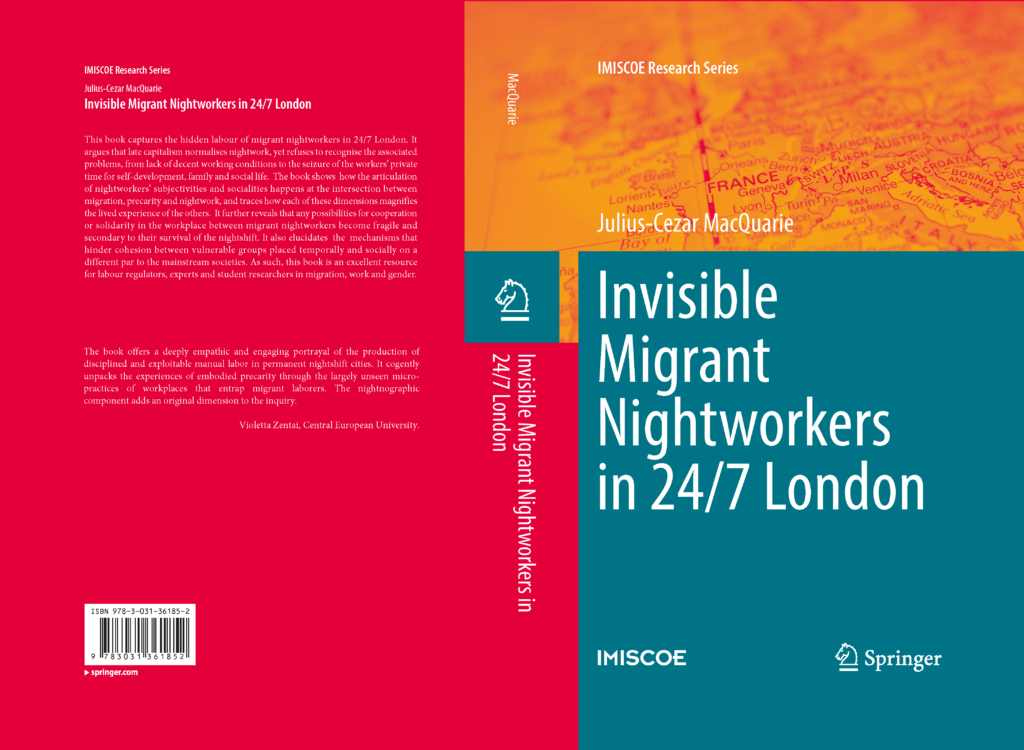
You have this wonderful insight – namely you talk about the structural invisibility of migrant nightshift workers. It is clear that there is strong anti-migrant propaganda, and a significant portion of the local population is hostile to workers both in the UK and much of Central and Eastern Europe. In the UK, how does this invisibility appear from the perspective of migrant workers? I understand that such invisibility is a conscious choice also of migrant workers. What are the concrete experiences and your insights?
My initial intent was to study the ways in which groups prefer to cooperate or engage in solidarity. In this case, I wanted to look at the Romanians and Turkish, partly because I spoke the language of both and so I had an easier point of entry, and partly because these were the largest migrant groups in the labor market. I wanted to look at cooperation and solidarity and I found different stories about embodied precarity. I’ve noticed, for example, that at certain companies, there were layers of intersecting hierarchies, linked by ethnic ties. You have the transnational corporations trading fruits and vegetables between Turkey and the UK. They have their pool of workers. So they could easily hire either by word of mouth in Turkey or via workers who would go on holiday in Turkey and bring back more workers. So there was a sort of shuttling between these workers who would come and do a few months or workers who were there for 14-20 years. These companies could access these workers in various ways, easily.
Romanians, who are EU citizens, had access to the labor market regularly and legally in 2015 when I did this fieldwork. But Turkish workers are third-country nationals and thus entering on business visas. After their business visa expires, they become illegal. So, they prefer to work in the dark because they are much less visible to regulators, normally operating during the “traditional” daytime shifts. I remember one night when immigration raided the market, but before the officers arrived, workers had already disappeared. Usually, night by night, those stands are packed with people, but when the raid happened, they were empty. Naturally, I was wondering what’s happening? Why? Where were the workers? And that actually demonstrated how many of them were undocumented migrants living in fear of the immigration authorities.
In the case of Romanians and Bulgarians it was different. They could, for example, declare to the tax office that they were working part time, when in fact they might have been at work for 16 hours at a time, in just one shift. That’s how they ended up in such irregularity and that’s why they prefer the night shift, because there was this lack of control over them.
One of them, a Romanian Roma worker, said to me, “I’ve worked here for years and I haven’t seen someone come and check that CCTV and say, hold on a minute, you know this worker has been here for 16 hours in just one night, why is that?” He said the only time he saw some sort of authorities was when they did these immigration raids. I have come across this information because this person asked for my help and support against an employer who promised a contract and all the conditions but didn’t actually deliver one. At this point he was reaching out to everyone to get support. But, as it happens with migrants who provide for their families, especially those who are the sole breadwinners, two weeks later, he gave up this plan and went back to the previous employer who also abused him, which was also the reason why he left initially. He had to provide for his family. His English language skills did not allow him to seek work elsewhere. At the market where he worked they spoke Turkish, which kept him there. Also it’s worth mentioning that it is somewhat unfair to call these people low-skilled workers because we’re talking about someone who speaks three languages – Romani, his native tongue, Romanian, and Turkish – because of ethnic ties. So in this environment he can navigate, but outside of that nightwork environment there was no alternative. That’s why he completely gave up on pursuing his complaint against the abusive employer, by the time I reached out to the embassy and spoke to the relevant people. It was rather disappointing that he didn’t want to pursue it further, but totally understandable.
If I understand correctly, the Nightworkshop methodology and perhaps more concretely the Nightworker Charter in a way makes the invisible workers visible. Can you tell us more about how the Charter does this trick?
The trick as you call it is to reach out to the right ears, to the right eyes, that’s what the Nightworker Charter does. It’s a tool to reach out to various audiences. It aims to communicate a specific set of problems and to engage certain stakeholders like unions, politicians, the media.
The Nightworker Charter addresses mainly the unions because they have the knowledge, the standing, and the sort of expertise needed. Unions can be listened to by politicians, and you know they can speak truth to power. This was the brainchild of an anthropologist and other NGOs, because I didn’t just come up with the Nightworker Charter alone. It came via discussions that I had with Migrant Voice, journalists, and activists.
Nighttime.org is another example of collaborative work, through my contribution to their chapter (4) on supporting Nightlife Workers.
The Nightworker Charter basically addresses three main areas. One of them is that nightwork needs to be recognized as a standalone form of work in legal terms.
The second aim is to address multilayered precarity, in particular the precarious situation of migrants and women. When I say multilayered precarity, I mean: if you are migrant, you’re working at night in precarious conditions, you are guaranteed to end up in this sort of job; and if on top, you’re a woman, you’re guaranteed to be at the bottom of that precarity. The reason has to do with the inequalities that exist within the current system of labor, with nightwork being like something adjacent, like an appendix to daytime work. That’s what I mean when I say it should be recognized as a standalone form of work.
Third, in legal terms, nightwork needs to be recognized as a form of work of its own. By doing that, we can then look specifically at problems that are characteristic to nightwork.
As I mentioned earlier, the commitment here is to see that the invisibility of nightwork is resolved. When I say invisibility, I don’t mean that you can’t see these people. But they are invisible from public debates, political agendas, and discussions about societal problems. Especially for 24/7 societies relying on migrant networks, this is a very relevant discussion. So this is what the Nightworker Charter does. Key stakeholders, at the helm of EU and the UK, would listen much more to an organization or institution, than to some individuals who put together the Nightworker Charter.
There is a specific sort of framework with specific issues that needs to be addressed and put in place for these changes to happen. Workers should:
● Be able to opt out of nightwork, if unsuitable for family or social life
● Be given extra support to care for children under 12
● Not be afraid of the employer if they refuse to do the night shift
● Be entitled to regular medical check-ups
Take for example the issues that are now discussed by the International Agency of Research Against Cancer. They found that people who work the nightshift suffer from several problems. Additionally, researchers have been studying the negative effects of social jetlag on people who lack sleep. Night shift workers are one such group that has to be up and alert at night, and continuously suffering from what I call “nightshift jetlag.”
The low point in the circadian 24 rhythm actually tells us that we should be lying down and sleeping and resting at night, not working and being alert. As it happened, my knees jerked, and I nearly fell a couple of times exactly around 04:00 am. I noticed this “scheduled” reaction, as there was a customer who always wanted my attention, always wanted me to help him put the order together. On a couple of occasions, he had to hold me because I just couldn’t do anything. My system, my body wanted to lay down and because I had to be alert with this particular customer, my body would just refuse to stand. And these are issues that need to be addressed and they can’t be addressed in a place where you don’t even have a table to eat, a chair to sit on while eating, or a room to rest during a break, if you have one. You don’t have regular breaks because for the employer that’s the peak time of the markets and you have to keep moving. You know, if you’re lucky, you may have your lunch, breakfast, or whatever it is at 02:30 AM.
These are some of the issues that need to be properly addressed.
I have been talking about the Nightworker Charter to institutions, but I think it’s really important to say that the public and individuals can also play a huge role: raising awareness, taking this further, spreading the word around among others. I urge readers to go to nightworkercharter.org and to sign and pledge to show the support for millions of night workers without which we would not be able to function on a daily basis.
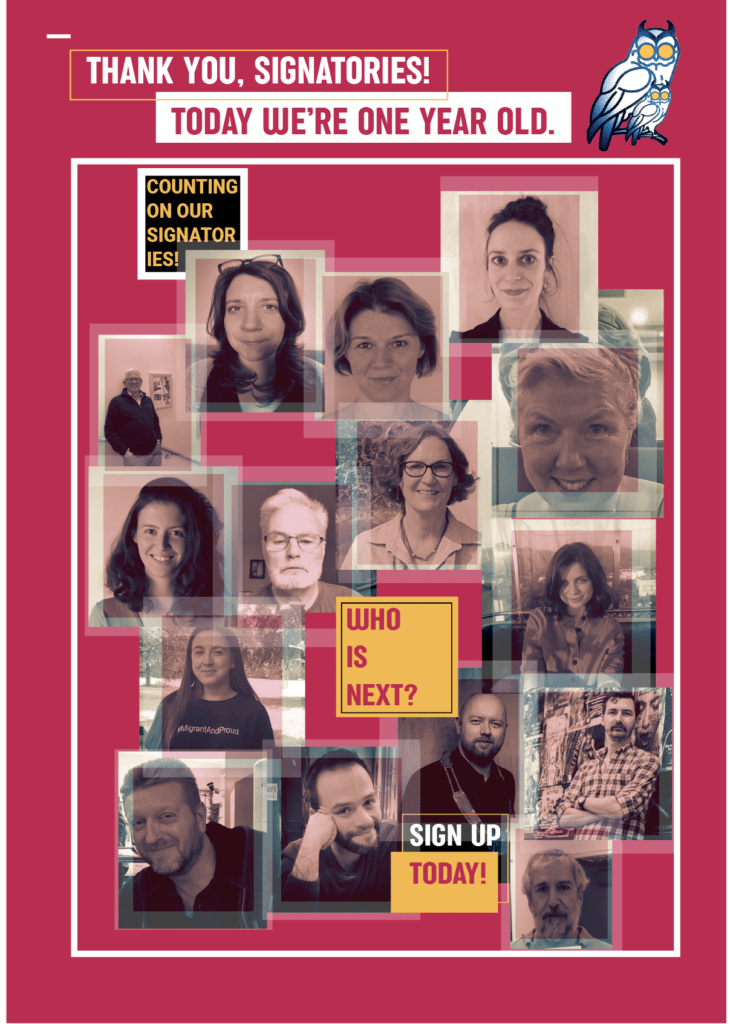
The Nightworker Charter begins with the following preamble “despite their strategic roles in the functioning of national economies, nightworkers are excluded from political agendas and public debates about who is and who is not an ‘essential’ or ‘key’ worker. There is a pressing demand for a new set of arrangements that address the specific problems with nightwork, e.g., invisibility, isolation, and tremendous negative impacts on health.” Most practically, the Nightworker Charter seeks to improve the working conditions of nightshift workers. You already told us the objectives of the Charter and how it operates. But since recently it was its one year anniversary – what changes did it induce and put in motion?
The anniversary of the Charter is on March 1. It’s important to highlight that this is the day of the UN agenda on Zero discrimination, one of the aspects which the Charter now addresses. It refers to the rights of women migrant nightworkers, in addition to what was there before. The 2023 edition stresses the needs of women migrant nightworkers specifically, in line with the research aims of the European Commission-funded project that I currently conduct in Ireland, called PRECNIGHTS. Many women, for example, have talked to me about their fears to commute during the dark, unsociable hours, when there is little if any public transport in operation.
The Nightworkers Charter addresses concerns regarding women’s safety at night, and other similar issues. At present, there’s a growing interest in promoting nighttime, leisurely activities. But there’s a gap, in focus, between the efforts put in place to expand nightlife, and to increase revenues without addressing the needs of the nightlife workers. The local authorities seem to be committed to offering a “good night out” experience for those who can afford it, but do not include in their remit those who are up and working at night to make ends meet, in locales or night venues that provide nightlife.
To increase nighttime revenue, around 80 cities in the world have a Nighttime Economy Task Force advisor or czar. At first they were set up in major, global cities like New York and London, but gradually such nighttime governance plans have been adopted by smaller cities with vibrant nightlife, like Cork and Dublin in Ireland or Groningen, in the Netherlands. These task forces do not, however, support nightlife workers’ needs for better working conditions – pay above the minimum wages, spaces to eat while on breaks, ensured transportation for those on long commutes. The most recent example is the Irish 2022 Nighttime Taskforce, which states that those in precarious working conditions are not within their remit. So then my question is, if it’s not within the remit of such a Nightime Taskforce, then whose remit is it?
Continuing in this direction, more focused on increasing revenue at night time and less on decent and fair working conditions to improve the livelihoods of those who deliver services at night, leads to furthering structural invisibility and precarity of the nighttime workforce. Fighting these large, structural problems that reproduce invisibility, precarity, and hence marginalization of manual, “low” skilled workers begs for support from all relevant stakeholders – unions, politicians, work and workers’ rights organizations, and researchers – to stop the spread of these evils.
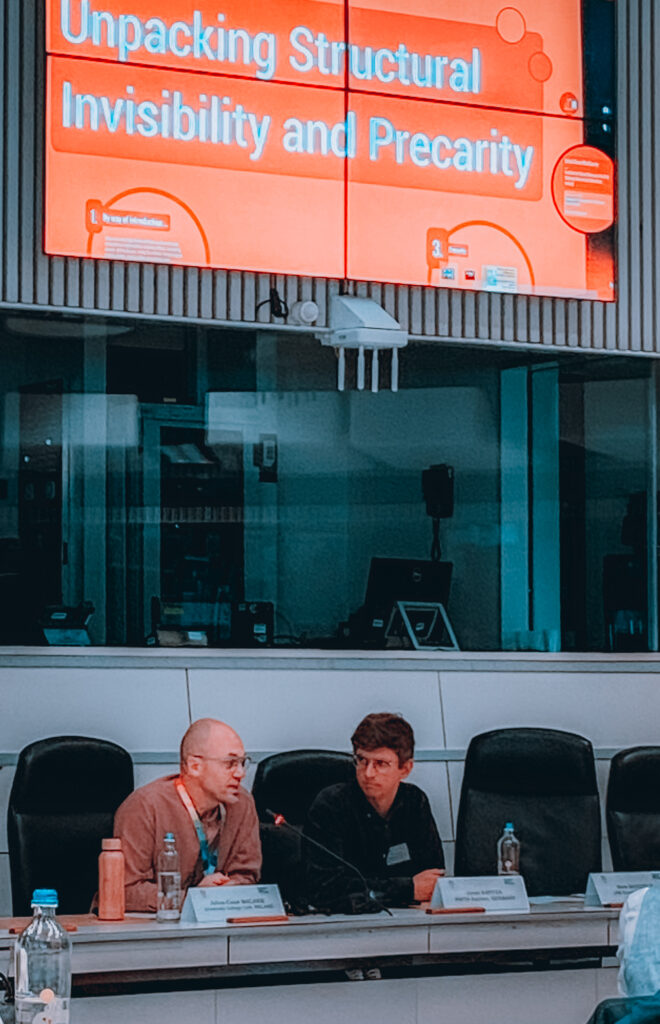
Julius-Cezar MacQuarie is a night ethnographer and migration scholar whose research focuses on migrant nightshift workers.
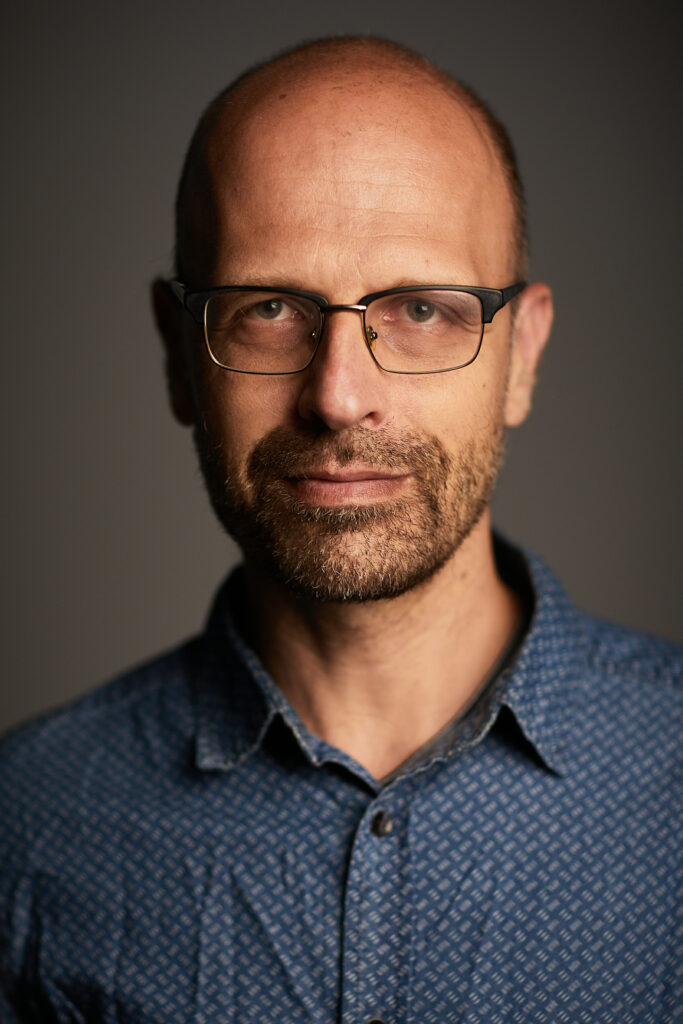
Tibor T. Meszmann is a researcher at the Central European Labor Studies Institute, Bratislava. His research is at the border of the interdisciplinary areas of industrial relations and sociology of work.

